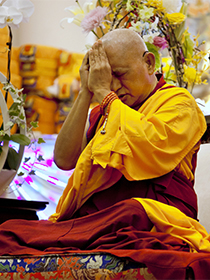- Home
- FPMT Homepage
Foundation for the Preservation of the Mahayana Tradition
The FPMT is an organization devoted to preserving and spreading Mahayana Buddhism worldwide by creating opportunities to listen, reflect, meditate, practice and actualize the unmistaken teachings of the Buddha and based on that experience spreading the Dharma to sentient beings. We provide integrated education through which people’s minds and hearts can be transformed into their highest potential for the benefit of others, inspired by an attitude of universal responsibility and service. We are committed to creating harmonious environments and helping all beings develop their full potential of infinite wisdom and compassion. Our organization is based on the Buddhist tradition of Lama Tsongkhapa of Tibet as taught to us by our founders Lama Thubten Yeshe and Lama Thubten Zopa Rinpoche.
- Willkommen
Die Stiftung zur Erhaltung der Mahayana Tradition (FPMT) ist eine Organisation, die sich weltweit für die Erhaltung und Verbreitung des Mahayana-Buddhismus einsetzt, indem sie Möglichkeiten schafft, den makellosen Lehren des Buddha zuzuhören, über sie zur reflektieren und zu meditieren und auf der Grundlage dieser Erfahrung das Dharma unter den Lebewesen zu verbreiten.
Wir bieten integrierte Schulungswege an, durch denen der Geist und das Herz der Menschen in ihr höchstes Potential verwandelt werden zum Wohl der anderen – inspiriert durch eine Haltung der universellen Verantwortung und dem Wunsch zu dienen. Wir haben uns verpflichtet, harmonische Umgebungen zu schaffen und allen Wesen zu helfen, ihr volles Potenzial unendlicher Weisheit und grenzenlosen Mitgefühls zu verwirklichen.
Unsere Organisation basiert auf der buddhistischen Tradition von Lama Tsongkhapa von Tibet, so wie sie uns von unseren Gründern Lama Thubten Yeshe und Lama Thubten Zopa Rinpoche gelehrt wird.
- Bienvenidos
La Fundación para la preservación de la tradición Mahayana (FPMT) es una organización que se dedica a preservar y difundir el budismo Mahayana en todo el mundo, creando oportunidades para escuchar, reflexionar, meditar, practicar y actualizar las enseñanzas inconfundibles de Buda y en base a esa experiencia difundir el Dharma a los seres.
Proporcionamos una educación integrada a través de la cual las mentes y los corazones de las personas se pueden transformar en su mayor potencial para el beneficio de los demás, inspirados por una actitud de responsabilidad y servicio universales. Estamos comprometidos a crear ambientes armoniosos y ayudar a todos los seres a desarrollar todo su potencial de infinita sabiduría y compasión.
Nuestra organización se basa en la tradición budista de Lama Tsongkhapa del Tíbet como nos lo enseñaron nuestros fundadores Lama Thubten Yeshe y Lama Zopa Rinpoche.
A continuación puede ver una lista de los centros y sus páginas web en su lengua preferida.
- Bienvenue
L’organisation de la FPMT a pour vocation la préservation et la diffusion du bouddhisme du mahayana dans le monde entier. Elle offre l’opportunité d’écouter, de réfléchir, de méditer, de pratiquer et de réaliser les enseignements excellents du Bouddha, pour ensuite transmettre le Dharma à tous les êtres. Nous proposons une formation intégrée grâce à laquelle le cœur et l’esprit de chacun peuvent accomplir leur potentiel le plus élevé pour le bien d’autrui, inspirés par le sens du service et une responsabilité universelle. Nous nous engageons à créer un environnement harmonieux et à aider tous les êtres à épanouir leur potentiel illimité de compassion et de sagesse. Notre organisation s’appuie sur la tradition guéloukpa de Lama Tsongkhapa du Tibet, telle qu’elle a été enseignée par nos fondateurs Lama Thoubtèn Yéshé et Lama Zopa Rinpoché.
Visitez le site de notre Editions Mahayana pour les traductions, conseils et nouvelles du Bureau international en français.
Voici une liste de centres et de leurs sites dans votre langue préférée
- Benvenuto
L’FPMT è un organizzazione il cui scopo è preservare e diffondere il Buddhismo Mahayana nel mondo, creando occasioni di ascolto, riflessione, meditazione e pratica dei perfetti insegnamenti del Buddha, al fine di attualizzare e diffondere il Dharma fra tutti gli esseri senzienti.
Offriamo un’educazione integrata, che può trasformare la mente e i cuori delle persone nel loro massimo potenziale, per il beneficio di tutti gli esseri, ispirati da un’attitudine di responsabilità universale e di servizio.
Il nostro obiettivo è quello di creare contesti armoniosi e aiutare tutti gli esseri a sviluppare in modo completo le proprie potenzialità di infinita saggezza e compassione.
La nostra organizzazione si basa sulla tradizione buddhista di Lama Tsongkhapa del Tibet, così come ci è stata insegnata dai nostri fondatori Lama Thubten Yeshe e Lama Zopa Rinpoche.
Di seguito potete trovare un elenco dei centri e dei loro siti nella lingua da voi prescelta.
- 欢迎 / 歡迎
简体中文
“护持大乘法脉基金会”( 英文简称:FPMT。全名:Foundation for the Preservation of the Mahayana Tradition) 是一个致力于护持和弘扬大乘佛法的国际佛教组织。我们提供听闻,思维,禅修,修行和实证佛陀无误教法的机会,以便让一切众生都能够享受佛法的指引和滋润。
我们全力创造和谐融洽的环境, 为人们提供解行并重的完整佛法教育,以便启发内在的环宇悲心及责任心,并开发内心所蕴藏的巨大潜能 — 无限的智慧与悲心 — 以便利益和服务一切有情。
FPMT的创办人是图腾耶喜喇嘛和喇嘛梭巴仁波切。我们所修习的是由两位上师所教导的,西藏喀巴大师的佛法传承。
繁體中文
護持大乘法脈基金會”( 英文簡稱:FPMT。全名:Found
ation for the Preservation of the Mahayana Tradition ) 是一個致力於護持和弘揚大乘佛法的國際佛教組織。我們提供聽聞, 思維,禪修,修行和實證佛陀無誤教法的機會,以便讓一切眾生都能 夠享受佛法的指引和滋潤。 我們全力創造和諧融洽的環境,
為人們提供解行並重的完整佛法教育,以便啟發內在的環宇悲心及責 任心,並開發內心所蘊藏的巨大潛能 — 無限的智慧與悲心 – – 以便利益和服務一切有情。 FPMT的創辦人是圖騰耶喜喇嘛和喇嘛梭巴仁波切。
我們所修習的是由兩位上師所教導的,西藏喀巴大師的佛法傳承。 察看道场信息:
- FPMT Homepage
- News/Media
-
- Study & Practice
-
-
- About FPMT Education Services
- Latest News
- Programs
- New to Buddhism?
- Buddhist Mind Science: Activating Your Potential
- Heart Advice for Death and Dying
- Discovering Buddhism
- Living in the Path
- Exploring Buddhism
- FPMT Basic Program
- FPMT Masters Program
- FPMT In-Depth Meditation Training
- Maitripa College
- Lotsawa Rinchen Zangpo Translator Program
- Universal Education for Compassion & Wisdom
- Online Learning Center
-
- Prayers & Practice Materials
- Overview of Prayers & Practices
- Full Catalogue of Prayers & Practice Materials
- Explore Popular Topics
- Benefiting Animals
- Chenrezig Resources
- Death & Dying Resources
- Lama Chopa (Guru Puja)
- Lama Zopa Rinpoche: Compendium of Precious Instructions
- Lama Zopa Rinpoche: Life Practice Advice
- Lama Zopa Rinpoche Practice Series
- Lamrim Resources
- Mantras
- Prayer Book Updates
- Purification Practices
- Sutras
- Thought Transformation (Lojong)
- Audio Materials
- Dharma Dates - Tibetan Calendar
- Translation Services
- Publishing Services
- Ways to Offer Support
- Prayers & Practice Materials
-
- Teachings and Advice
- Find Teachings and Advice
- Lama Zopa Rinpoche Advice Page
- Lama Zopa Rinpoche: Compendium of Precious Instructions
- Lama Zopa Rinpoche Video Teachings
- ༧སྐྱབས་རྗེ་བཟོད་པ་རིན་པོ་ཆེ་མཆོག་ནས་སྩལ་བའི་བཀའ་སློབ་བརྙན་འཕྲིན།
- Podcasts
- Lama Yeshe Wisdom Archive
- Buddhism FAQ
- Dharma for Young People
- Resources on Holy Objects
- Teachings and Advice
-
-
*If a menu item has a submenu clicking once will expand the menu clicking twice will open the page.
-
-
- Centers
-
- Teachers
-
- Projects
-
-
-
-
*If a menu item has a submenu clicking once will expand the menu clicking twice will open the page.
-
-
- FPMT
-
-
-
-
-
The workshop is in the mind.
Lama Zopa Rinpoche
-
-
-
- Shop
-
-
-
The Foundation Store is FPMT’s online shop and features a vast selection of Buddhist study and practice materials written or recommended by our lineage gurus. These items include homestudy programs, prayers and practices in PDF or eBook format, materials for children, and other resources to support practitioners.
Items displayed in the shop are made available for Dharma practice and educational purposes, and never for the purpose of profiting from their sale. Please read FPMT Foundation Store Policy Regarding Dharma Items for more information.
-
-
Obituaries
12
Venerable Jangchup Phegey passed away peacefully in his sleep on November 25th 2023.
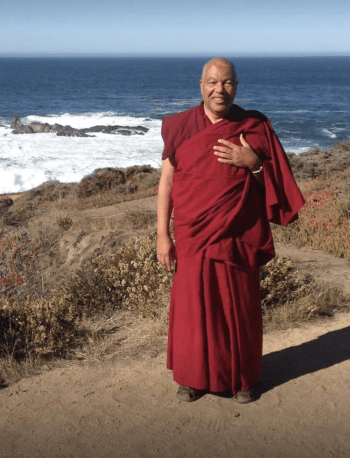
Venerable Jangchup Phegey.
Written by Jacob Lindsley
Ven. Jangchup leaves behind a life of Dharma practice, friendship, and service. Born Hawkins Mitchell in San Diego, California, Ven. Jangchup earned a PhD in developmental psychology, worked as a clinician, traveled the world, and worked as a writer. He heard the Dharma in the late 1980s, took refuge with Geshe Geltsen and was soon ordained by Lati Rinpoche at Ganden Shartse Monastery in India at 51 years old.
Ven. Jangchup was known for his humor and generosity. He spent his later years deep in the redwoods of the Santa Cruz mountains at Vajrapani Institute, in a hermitage disguised as an airstream trailer tucked away in a bend of dirt road leading to the ridgeline where Lama Yeshe was cremated. His door was always open to visitors and travelers to Vajrapani Institute, and he made countless friends with his contagious joy and earnest curiosity. He cared deeply about people and animals alike.
Ven. Jangchup was unconventional, creative, graceful, and filled a room with light. He was a deep thinker and had strong conviction in the Dharma. He was devoted to Lama Zopa Rinpoche and spent many years completing Nyung Na retreats, praying, meditating, writing, and comforting those around him.
Former director of Vajrapani Institute, Ven. Thubten Drolma, shared, “His door was always open for people. For years I’d stop by on my way home and he’d make me a cup of tea. He was one of the best conversationalist I ever knew. His was a generous and warm heart.”
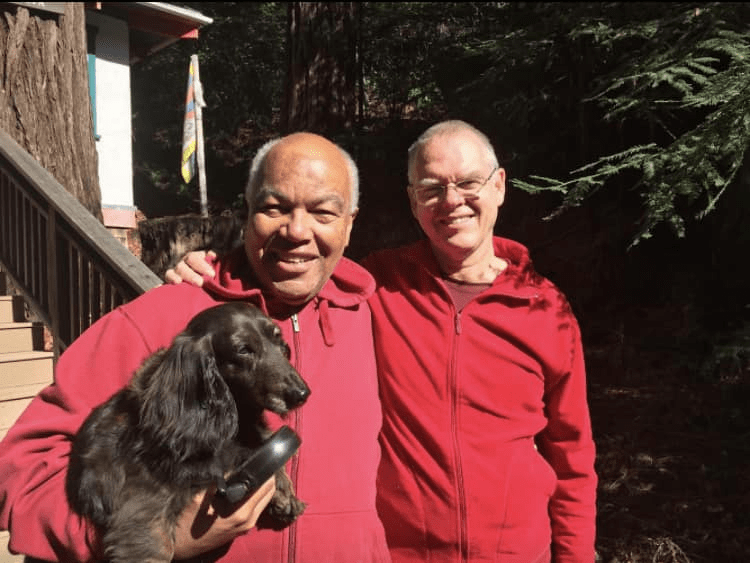
Ven. Jangchup with Ven. Rene Feusi and Ven. Jangchub’s dog, Bodhi.
He is grieved by his family and friends. May our precious teachers take good care of him in all future lives. We hope to meet again, Venerable.
Ven. Jangchup was a frequent contributor to the Vajrapani blog as well as the San Diego Reader.
Please pray that Ven. Jangchup may never ever be reborn in the lower realms, may he be immediately born in a pure land where he can be enlightened or to receive a perfect human body, meet the Mahayana teachings and meet a perfectly qualified guru and by only pleasing the guru’s mind, achieve enlightenment as quickly as possible. More advice from Lama Zopa Rinpoche on death and dying is available, see Death and Dying: Practices and Resources (fpmt.org/death/).
To read more obituaries from the international FPMT mandala, and to find information on submission guidelines, please visit our new Obituaries page (fpmt.org/media/obituaries/).
- Tagged: obituaries, obituary
8
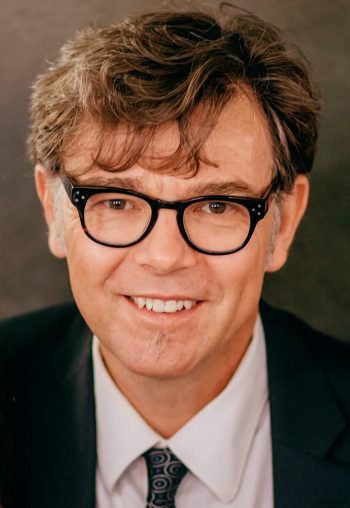
Arunas Antanaitas, photo courtesy of Arunas’ Facebook page.
Arunas Antanaitas, 62, passed away peacefully on Vesak, May 5, 2023 in Dundas, Ontario, Canada, of cancer.
Arunas had embarked on his cancer journey 17 months prior with grace, dignity, and a contagiously positive outlook. His last days were filled with prayers, surrounded by his loved ones. Arunas will be remembered for his compassion, love of conversation, propensity for playfulness, and unwavering desire to help others.
Arunas served as the center director for Lama Yeshe Ling, seeing the center transform from a meeting place in his and Sharon’s basement studio to hosting our resident teacher Geshe Sonam Ngodrup (Geshe Sega) and Tibetan language interpreter Venerable Jamyang Khedrup. Our community supported Arunas in his wish to serve as director until his last breath, with Lama Zopa Rinpoche’s last advice to Arunas being for him to rejoice in his having served Rinpoche in this way. During his illness, Arunas was able to fulfill all of Rinpoche’s advice, along with the support of our community. For example, Geshe Sonam conveyed the Amitayus Long Life initiation, we did many group recitations of the long life sutra, and an animal liberation. A month earlier, Khensur Rinpoche Lobsang Delek taught at Lama Yeshe Ling and conferred the initiation into Arunas’ main practice. Khensur Rinpoche remarked that he was impressed that Arunas attended every event despite it being so very clear that Arunas was very weak and in pain.
In one of the last letters to Lama Zopa Rinpoche, Arunas asked if Rinpoche agreed with the doctor’s view that he had now become ‘palliative’. Rinpoche’s reply was: “a good practitioner is always palliative”. Arunas had discussed and coached his family and the hospice staff about the Buddhist view and practice of dying, and everyone was supportive of how he wished to die. They found a hospice that supported leaving his body undisturbed for three days. At the hospice, Geshe Sonam and Khedrup came to visit, as well as fellow practitioners several times coming together to meditate and pray. Moments after Arunas’ last breath, Geshe la, Khedrup la, and a small group of sangha and family performed the Guru Puja, with Geshe la leading us in visualizing Arunas receiving the four initiations, and the dissolution of the guru in the heart.
One of the palliative care nurses mentioned that everyone she had cared for there was afraid of death, as was she. It was remarkable for her to observe that Arunas was not afraid, and neither were the people around him. Arunas wanted to live longer, and he did everything possible to do so, for he had more he wanted to offer. It is sad that this good person is no longer with us here. However we know this isn’t the end, and we pray that Arunas finds the way to manifest again as a good person, to connect very early with the Dharma, and continue his path of service to the guru for the benefit of beings.
Please pray that Arunas may never ever be reborn in the lower realms, may he be immediately born in a pure land where he can be enlightened or to receive a perfect human body, meet the Mahayana teachings and meet a perfectly qualified guru and by only pleasing the guru’s mind, achieve enlightenment as quickly as possible. More advice from Lama Zopa Ripoche on death and dying is available, see Death and Dying: Practices and Resources (fpmt.org/death/).
To read more obituaries from the international FPMT mandala, and to find information on submission guidelines, please visit our new Obituaries page (fpmt.org/media/obituaries/).
- Tagged: obituaries, obituary
7
David Williams passed away at the age of 65 years in his room at the Great Stupa of Universal Compassion in Bendigo, Australia on January 25, 2023. Ian Green, the director of the Great Stupa, reflects some on David’s life and kindly reached out to friends to share what they admired most about David, who became a student of Lama Yeshe and Lama Zopa Rinpoche in the early 1980’s. We invite you to read the inspiring reflections about a longtime Dharma friend below:
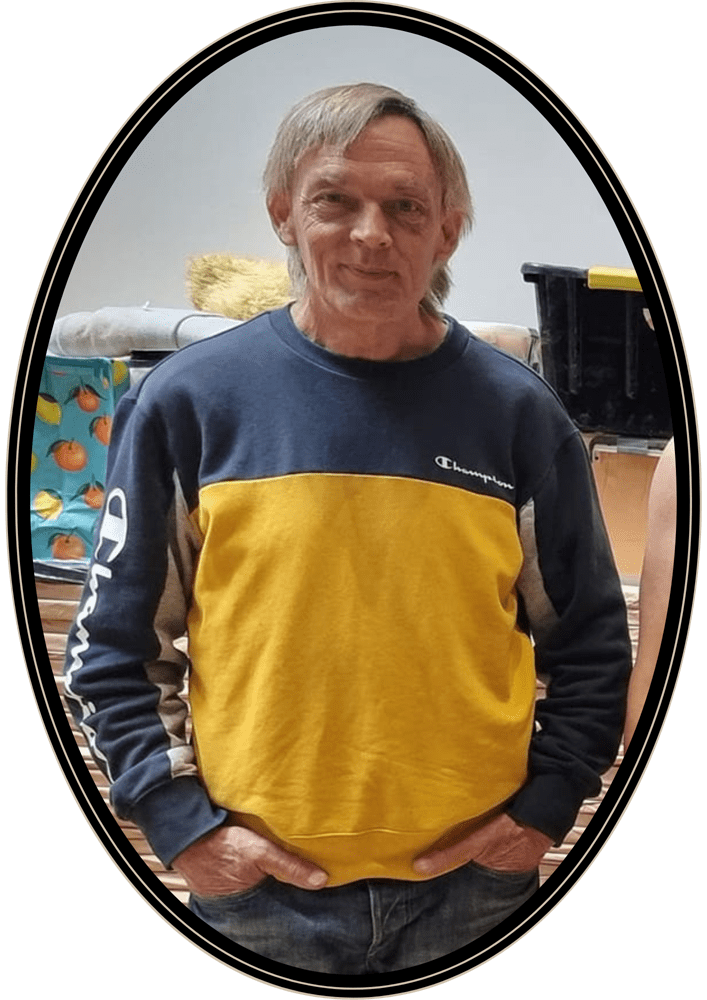
David Williams. Photo courtesy of the Great Stupa.
“David came to the stupa in early 2021”, shares Ian Green, “and spent his first year completing the massive water bowl offering commitment that he had made to Lama Zopa Rinpoche. After this was fulfilled, he threw his energy into volunteering at the stupa. This work included plastering and painting the enormous walls inside the stupa, painting prayer wheels and other holy objects, and even floors in the stupa and the new library. Most recently, David completed waterproofing on the stupa and he was making preparations for the filling of the huge Ksitigarbha statue. David was liked and admired by members of the works and arts teams at the stupa. As we rejoice in his wonderful achievements, we know he will be sadly missed by us all at the stupa.”
Angelica Geiger reflects that David was true to himself and devoted to the Dharma, “From our first meeting at Kopan in 1983, he always did his Dharma practices without question. He was committed to fulfilling his promise to Lama Yeshe to do one million prostrations which he completed in the early 1990’s. He loved a well-made cup of tea and a Dharma chat that touched one’s heart and raised the spirit. He also cared for his mother with kindness, warmth and humor.”
Brian Ashen describes David as a hidden gem of a practitioner, “I first met David at the 1984 Kopan course where I observed David would not follow the rules of the retreat by observing silence. He kept chitchatting and we thought he would not progress much. How wrong we were.”
Frank Brock remembers of David, “I first met David in 1983 at Tushita Retreat Centre in Dharamsala where his good humour and concern for others meant he was able to offer support to those who were struggling with the retreat. I think for those who had the pleasure of knowing him he was the very embodiment of the term ‘good heart.’”
Murray Wright and Roy Fraser recall David’s contribution in New Zealand. As Murray explains, “David was part of the group that did the first one-year Vajrasattva retreat at Mahamudra Centre in the 1980’s. He lived at Dorje Chang Institute for over 10 years, was generally quite private, but very friendly and helpful. He worked with William Hursthouse building the stupa at DCI in 1996.”
John Wright recalls meeting David at Atisha Centre in the 1980’s and then at Tara Institute around 2014. “David was not one of the scholars or academics, or people who got involved in leadership, but just kept things simple and operated with Dharma as a priority.”
Helen Cameron remembers David fondly, “He was such an Aussie. You’d never know he had a spiritual side until you got to know him.”
Please join us in rejoicing in the life of David Williams, a hidden gem of a practitioner whose Dharma practice and efforts for the Great Stupa will be remembered as causes for inspiration for us all.
Lama Zopa Rinpoche requests that students who read obituaries pray that the person mentioned finds a perfect human body, meets a Mahayana guru, and becomes enlightened quickly, or be born in a pure land where the tantric teachings exist and they can become enlightened.” While reading obituaries we can also reflect on our own death and impermanence prompting us to live our lives in the most meaningful way. More advice from Lama Zopa Ripoche on death and dying is available, see Death and Dying: Practices and Resources (fpmt.org/death/).
To read more obituaries from the international FPMT mandala, and to find information on submission guidelines, please visit our new Obituaries page (fpmt.org/media/obituaries/).
- Tagged: obituaries, obituary
19
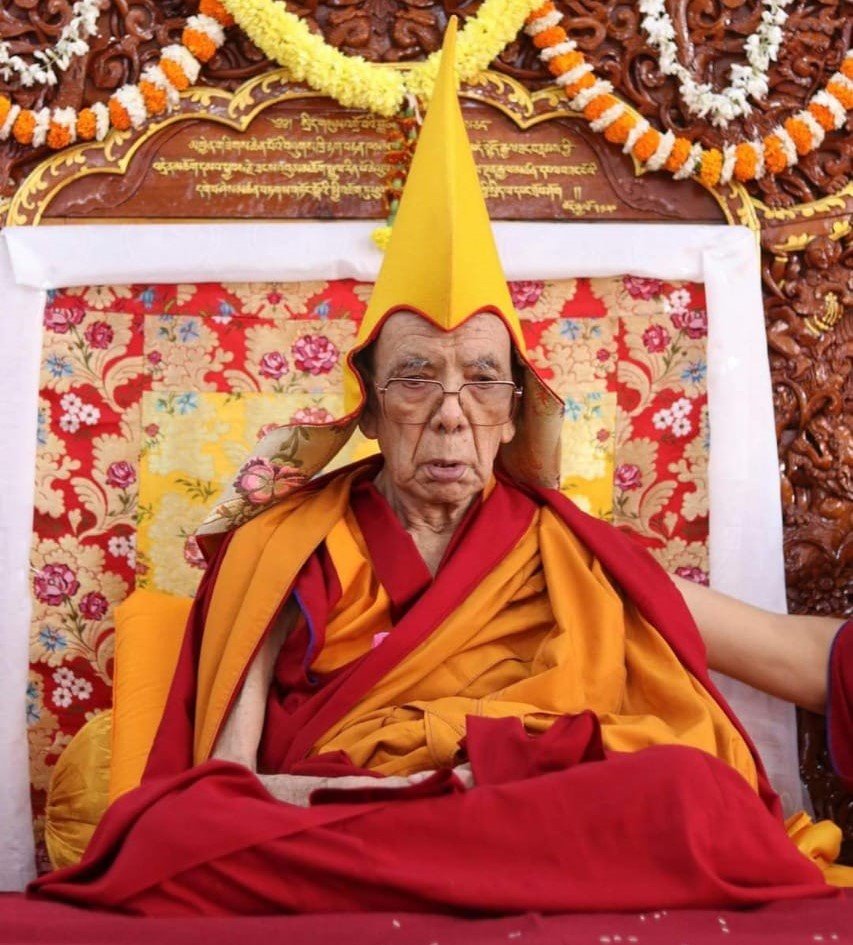
The 102nd Ganden Tripa Rizong Rinpoche. Photo courtesy of Drepung Loseling Monastery Facebook page.
The 102nd Ganden Tripa Rizong Rinpoche, one of Lama Zopa Rinpoche’s gurus, passed away on December 8, 2022 at Drepung Monastery, Karnataka, India, at age 94.
Ganden Trisur Rizong Sras Rinpoche was born in Ladakh, India in 1928, to an aristocratic family, his father being a prince of Ladakh. At age four, he was recognized as the previous Sras Rinpoche by the thirteenth Dalai Lama, who had founded the well-known Rizong retreat hermitage. After being recognized, Rinpoche entered monastic life. In 1948, Rinpoche moved to Tibet to continue his studies at Drepung Loseling Monastery in Lhasa. He remained there in Tibet until the Chinese invasion in 1959, when he fled back to India.
Back in India, Rizong Rinpoche would later be named the abbot of the Drepung Loseling Monastery in India by His Holiness the Dalai Lama, in 1984. Rinpoche later became abbot of Gyume Tantric Monastery, and then served as Ganden Choje, the position held before becoming Ganden Tripa (Ganden Throneholder). In 2009, Rinpoche was appointed as the 102nd Ganden Tripa, the spiritual head of the Gelug lineage, and served the traditional full-term of seven years, retiring from the position in 2016.
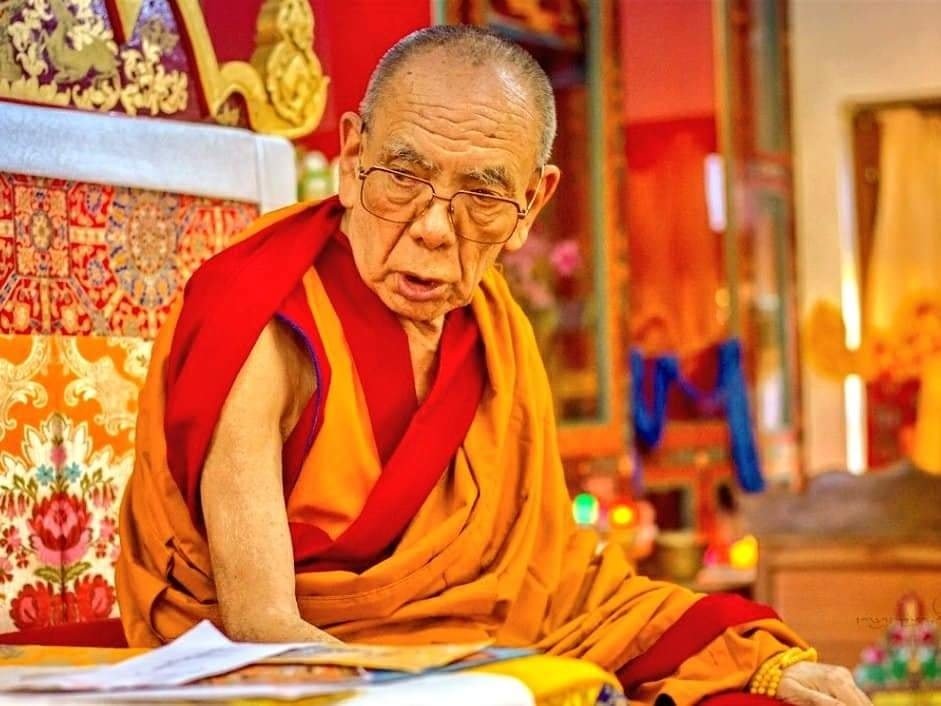
The 102nd Ganden Tripa Rizong Rinpoche. Photo courtesy of Voice of Tibet Facebook page.
The Central Tibetan Administration offers some of Rinpoche’s biography:
“Rinpoche …made the practice of meditation his principal focus in life, and has conducted numerous extensive retreats, including a three-year tantric retreat on the Yamantaka mandala in a remote hermitage in Ladakh. Through his achievements in practice and scholarship, he represents the pinnacle of the Sutra and Tantra traditions.
Rinpoche was renowned for his Tantric powers, and [was] frequently called upon by His Holiness the Dalai Lama to lead ceremonies for healing and other similar purposes.”
His Holiness the Dalai Lama shared some words on December 9, 2022, the morning after Rizong Rinpoche’s passing, while at a conference on secular education:
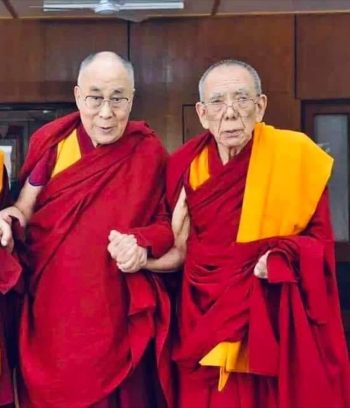
His Holiness the Dalai Lama with Ganden Trisur Rizong Rinpoche. Photo courtesy of Drepung Loseling Monastery Facebook page.
“Today, many old friends have gathered here. It’s with sadness that I’ve heard this morning that Kyabje Rizong Rinpoche, the former Ganden Throneholder, passed away last night. Although his passing away is a natural part of life, I’m sad because he was one of my teachers.
“I once visited him in Ladakh at a time when he was completing a long meditation retreat. He received me sitting on the very seat where he had been meditating so long and gave me the transmission of Nagarjuna’s Six Collections of Reasoning. His death reminds me of the Four Seals:
All conditioned phenomena are transient.
All polluted phenomena are unsatisfactory or in the nature of suffering.
All phenomena are empty and selfless.
Nirvana is true peace.
“Unless we cut the chains of ignorance, we will be unable to stop the cycle of suffering. We have to understand that no matter how they appear, things have no independent or absolute existence.”
Lama Zopa Rinpoche, Khen Rinpoche Geshe Chonyi, and the Kopan Lama Gyupa monks offered Yamantaka self initiation upon the news of this great lamas passing.
We are profoundly sad at the incredible loss of this remarkable meditation master, scholar, and teacher, who was one of Lama Zopa Rinpoche’s gurus. We hope this outline of his life will be cause of rejoicing in his many good deeds and deep impact.
While reading obituaries we can also reflect on our own death and impermanence prompting us to live our lives in the most meaningful way. More advice from Lama Zopa Ripoche on death and dying is available, see Death and Dying: Practices and Resources (fpmt.org/death/).
To read more obituaries from the international FPMT mandala, and to find information on submission guidelines, please visit our new Obituaries page (fpmt.org/media/obituaries/).
16

Geshe Thubten Soepa sitting with some friends near Vulture Peak Mountain, Rajgir, India. Photo courtesy of Geshe Thubten Soepa Facebook page.
Geshe Thubten Soepa. 67, passed away at a hospital in Mysore, India, on November 2, 2022 from a heart attack.
Geshe Soepa was well regarded as a scholar with extensive knowledge about both sutra and tantra, and not only well versed in the Gelugpa texts, but also in those of the Nyingma, Sakya, and Kagyu schools. A cremation ceremony occurred on November 7, 2022. We share a brief account of his life below for rejoicing and inspiration:
Geshe Thubten Soepa was born in Zanskar, India in 1955. As a young child he and his mother were advised by His Holiness Ling Rinpoche and His Holiness Dilgo Khyentse Rinpoche that it would be good if he ordained, and he soon followed their guidance. Geshe Soepa began his Dharma studies at age 14 at Domo Geshe Rinpoche’s monastery in Kalimpong, India, where he studied and learned ritual for four years. From there he transferred to Sera Je Monastery in Bylakuppe, India, where he would complete his geshe studies 21 years later, earning the highest honor of Geshe Lharampa, in 1993.
In his first three years serving as a geshe, he taught philosophy and Tibetan grammar at Sera Je and Dzongkar Chose monasteries. Geshe Thubten Soepa then received a request from Lama Zopa Rinpoche to teach in the West. Geshe Soepa agreed to Rinpoche’s request and moved to Munich, Germany. For ten years he continuously taught at FPMT centers in Germany, Austria, and Switzerland, while also traveling to other centers around Europe to offer teachings. After his time in Europe, the next decade of his life was mostly spent in North America, offering teachings at FPMT centers in Canada, Mexico and the United States.
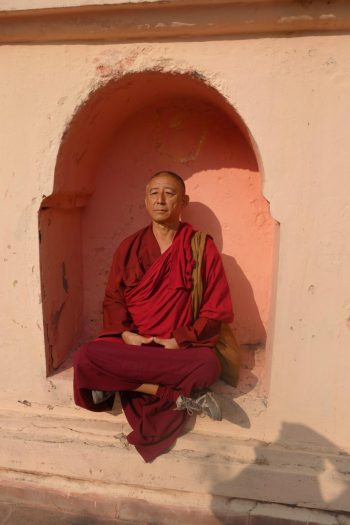
Geshe Thubten Soepa meditating at the Mahabodhi Temple in Bodhgaya, India. Photo courtesy of Geshe Thubten Soepa Facebook page.
Recognized as a Tulku
In his short autobiography, Geshe Soepa shared that he was told that he was the reincarnation of a high lama on three separate occasions. The first declaration was made by His Holiness Trijang Rinpoche in 1974, then again by His Eminence Zong Rinpoche in 1978. The last affirmation came from the great yogi Choden Rinpoche, during a public teaching Rinpoche was giving on the Six Yogas of Naropa in Munich, 2004. Geshe Soepa shared his shock and disbelief at hearing the news each time, even asking Choden Rinpoche if he was teasing him. Choden Rinpoche looked at Geshe Soepa and forcefully confirmed it was not a tease! Despite being recognized, Geshe Soepa was never formally enthroned or named after the particular teacher. In 1974, His Holiness Trijang Rinpoche shared with Geshe Soepa that a formal enthronement would not be necessary, foretelling that Geshe Soepa would “spontaneously be doing well at Dharma, and that [he] would like it.”
Promoting Vegetarianism and Protecting Life
Geshe Thubten Soepa was deeply passionate about promoting vegetarianism, especially to those living a monastic life. He would go on to write a number of books and articles on the practice of not eating meat, relying on sources such as the Lankavatara Sutra, Great Cloud Sutra, Great Nirvana Sutra, and the Anguli Mala Sutra, to communicate the Buddha’s teachings. His first book was titled Protecting the Lives of Helpless Beings: The Udamwara Lotus Flower, which is now available as an ebook through the Lama Yeshe Wisdom Archive. In 1996, while His Holiness the Dalai Lama was visiting Munich, Geshe Soepa was able to offer His Holiness a copy of his book. His Holiness told Geshe Soepa that he read the whole book, was very pleased by the text, and encouraged Geshe Soepa to continue his efforts on the topic.
In the years following, he would write four texts on vegetarianism that were translated in five languages and distributed freely. In 2012, Geshe Soepa published a short text on the Hinayana Vinaya teachings on monastics refraining from eating meat. During the 2017 Kalachakra initiation offered by His Holiness the Dalai Lama in Bodhgaya, India, Geshe Soepa was able to meet with Lama Zopa Rinpoche and offer Rinpoche this short text. Lama Zopa Rinpoche was also quite pleased by Geshe Soepa’s writing. Geshe Soepa told Rinpoche that he was planning to write another text to clarify further points, and Rinpoche expressed that the text should be translated into English, in order to be easily translated into many languages later. Geshe Soepa would go on to publish another text in Tibetan in 2018 for monastics. The text included teachings on performing animal liberations and advice for working to free people who were wrongly imprisoned.
Geshe Soepa concluded the short telling of his life story with the message: “I sincerely wish that all of our mother sentient beings be free from suffering and being killed.”

Geshe Thubten Soepa at the Mahabodhi Temple, Bodhgaya, India. Photo courtesy of Geshe Thubten Soepa Facebook page.
Read Geshe Thubten Soepa’s short autobiography, dictated to Robert Baptist, from which the above obituary was based, courtesy of Land of Compassion and Wisdom FPMT study group in Austin, Texas, who had a strong connection with Geshe Soepa and have hosted him often.
We invite you to download the ebook, Protecting the Lives of Helpless Beings: The Udamwara Lotus Flower, through the Lama Yeshe Wisdom Archive, and read an article by Geshe Soepa called “Protecting Animal Welfare“. A French translation of his text Heart of Joy, Message of the Buddha, is also available as a free PDF.
Lama Zopa Rinpoche requests that students who read obituaries pray that the person mentioned finds a perfect human body, meets a Mahayana guru, and becomes enlightened quickly, or be born in a pure land where the tantric teachings exist and they can become enlightened.” While reading obituaries we can also reflect on our own death and impermanence prompting us to live our lives in the most meaningful way. More advice from Lama Zopa Ripoche on death and dying is available, see Death and Dying: Practices and Resources (fpmt.org/death/).
To read more obituaries from the international FPMT mandala, and to find information on submission guidelines, please visit our new Obituaries page (fpmt.org/media/obituaries/).
- Tagged: geshe thubten soepa, obituaries, obituary
27
Jo Marie Galt, 71, died in Santa Cruz, US, on September 1, of cardiac arrest resulting from various contributing health factors.
By Elaine Jackson
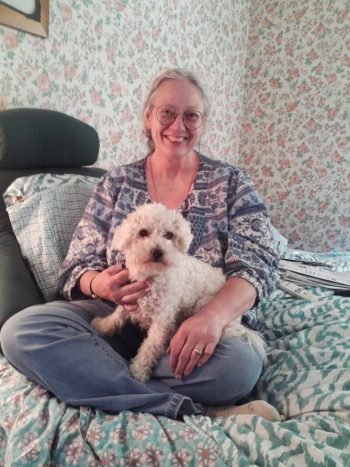
Jody Galt with dog Dawa. Photo courtesy of Shasta Wallace.
Jo Marie Galt (Jody) was loved by her Dharma family at Vajrapani Institute where we met in the late seventies and early eighties. She is remembered as always being the first one to volunteer for the hard jobs with a smile and determination. She will be deeply missed.
Jody was born on March 31, 1951, in Missouri, but most of her childhood, which she described as really difficult, was spent in Spokane, Washington. She was fourteen when her mother took her own life. Then, at sixteen, Jody ran away from home making strong prayers for answers.
Traveling in Mexico, Jody met Jim Ezell, her first husband and father of her daughter, Alicia, who was born in May, 1970. After Jody and Jim separated, Jody settled in Selma, Oregon where, together with Andy Robbins, she built a log cabin. It was here that their son, Ben, was born in 1978.
Jody had prophetic dreams. She described one dream where a book fell from the sky with one word on the page: “Vipassana.” She had no idea what that meant but became curious, went to the library, and began to read Dharma books.
In May 1980, Lama Yeshe led a Chenrezig retreat at Grizzly Lodge near Mount Shasta. It was sponsored by Vajrapani Institute. Jody sold her trailer to raise money to attend that course. It was there that she met Diney Woodsorrel and George Galt. After that course, Jody and her family moved to Berkeley.
Judy Weitzner recalled, “When Jody and Andy moved to the Berkeley Dharma House just after Grizzly Lodge, Jody was invaluable in her efforts to keep things organized. She was an exceptionally hard worker and contributed with cleaning and cooking. She attended many teachings and classes. Geshe Thardo was the resident teacher, but Lama Yeshe, Lobsang Chonjor, and Zong Rinpoche, as well as others, also offered teachings. It was at the Berkeley Dharma House where Jody first met Shasta Wallace, who was living at Vajrapani Institute at the time.” When the Dharma House closed in 1981, Jody moved to Vajrapani.
Jody said that Berkeley was too wild for her, so she went to Vajrapani. She and Andy had separated by then, but Andy came to Vajrapani from time to time, and eventually settled in Boulder Creek.
Shasta, a founder and long-time Vajrapani resident, recalls that Jody was always willing to jump in and help no matter how daunting the job. Shasta remembers such a job. It was cleaning and restoring a grease-laden, dilapidated-looking, commercial cookstove bought in San Francisco from an old restaurant in the Mission District. It looked like a wreck, but it needed to be functional for a retreat in one week. Jody told Shasta that not only could it be done, but it would be done. She helped take it apart, soak the encrusted parts and scrub it until it shined. It served as the cookstove in the Vajrapani kitchen for many years.
Initially, Jody and her children, Ben and Alicia, lived at Vajrapani in the “Dzome,” a canvas structure originally built by Rick Crangle and Jacie Keeley in 1978. It had an outdoor shower, an outhouse, and a small separate hut used for a kitchen. Jody was no stranger to rustic living. As she recalled, “Ben was three and Alicia was eight when we moved into the Dzome. That’s where I did my retreats – Tara and Vajrayogini. At 3:00 a.m. I would wake up. I loved it there so much. I wanted to be part of the community. I paid my $40.00 every month, hauled cement bags, and did what I could. In those days, we joked that I was living at Vajrapani, where you pay to work.”
Jody remembered working on the trails around the Chenrezig Gompa, while it was under construction, when Bill Kane came down with a terrible case of poison oak. Since Jody seemed to be immune, it became her job to pull the poison oak, and pull it she did, for two or three weeks. She ended up also getting the worst case of poison oak she had ever seen.
Janet Brooke recalls, “I met Jody when she arrived at Vajrapani in early 1981 following Lama Yeshe’s course at Grizzly Lodge. We were both mothers at the time. Her son Ben was a year older than my infant, Lise. There were many other children at Vajrapani who were close in age at the time, so Jody and I inevitably shared a lot of time around children.
“Jody and I also connected with the hard work needed to build this wonderful retreat center. We shared a love of gardening. Jody was very knowledgeable and experienced in this area. I learned so much from her. Together we had the opportunity to plant and create the garden beds around the stupa and surrounding the Vajrapani Gompa. This was all done under Jody’s expert guidance and skill and with great joy at being able to make such a wonderful offering. It was fun and, when working with Jody, it was guaranteed that somewhere along the way, no matter how hard the job, there would be a lot of laughter. Jody had a great sense of humor, and we shared a lot of laughter. There was hard work and there was laughter, and there were difficult times too. It was during the most difficult times in my life that Jody did her best, despite her own difficulties, to be there for me, as much as she was able, and I will be forever grateful.”
Jody had started a landscaping business and employed a few Vajrapani women who needed to make some money. Bev Gwyn remembers that two of Jody’s clients were Dick and Ramona Andre, who bought Lama Yeshe’s house in Rio del Mar (Santa Cruz), after Lama’s passing. Ramona loved Lama Zopa Rinpoche and Jody and maintained a relationship with Bev and Jody until her passing this year. Dick still lives in Lama’s house.
Following torrential rains, Jody’s beloved Dzome became unlivable when the roof collapsed. The family moved to Boulder Creek. Jody refers to Tom Waggoner as her “guardian angel,” who built her a house on Vajrapani land so she could move back about a year later. As she said, “It was the biggest gift of kindness.” Then, as luck would have it, that new house was irreparably damaged by a mudslide the following winter. Jody and the kids had to climb out a bedroom window to escape. They moved back to Boulder Creek.
In 1983, Lama Yeshe gave his last teaching a Vajrapani Institute when he taught the Six Yogas of Naropa. It was attended by so many of his beloved students, including Diney, George, and Jody. Diney was soon diagnosed with terminal cancer and died at the end of that year. Jody helped George as caregiver for Diney and also his three children, Shyela, Bodhi, and Sanje.
In October 1988, George and Jody were married. Jody continued to work in landscaping and engaging in other creative projects. She attributed her creativity to her mother who was an artist. Her parents had lived in Japan and her mother was greatly influenced by her time there. When Jody was living in the Berkeley Dharma House, she was quilting. Judy Weitzner shared that she gave Jody her old dresses which were cut up and returned to Judy in the form of a quilt with the Tara mantra on all four sides. Judy said it was the most heartfelt gift she ever received. Jody responded, “It was because of how much I treasured the gift of Dharma you gave me.”
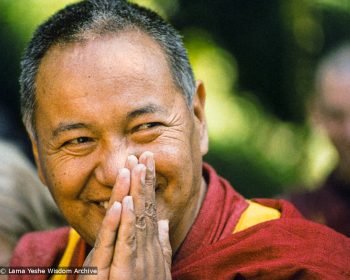
Lama Yeshe at a family gathering at Vajrapani Institute, California, 1983. Photo by Carol Royce-Wilder.
Jody once shared, “Lama told me it was always going to be really difficult for me to see him. I was very shy and had such low self-esteem that I felt I should not be bothering someone for whom I had so much respect. At Grizzly Lodge, on the last day, Lama said that anyone could come in to talk with him. I told myself, ‘OK this is it.’ I was intimidated, but Lama said, ‘I think you have something you wanted to ask me.’ I said, ‘Lama, if you appear in my dream and give me teachings, is that what I should take as the truth?’ Lama replied, ‘Whenever I appear to you, you can believe what I’m telling you, even in a dream form.’ That was so encouraging to me.”
Judy explains, “Vajrapani is a miracle. It is magnificent. Lois (Greenwood) and I were talking about how when Lama spoke, people heard different things. People often took different pieces of his vast vision to make real.”
For the last many years of her life, Jody lived in pain from a degenerative spinal disease which led to half a dozen surgeries. Additionally, Jody’s immune system was attacking her nervous system leading to pain, numbness, and loss of motor control, for which she endured ongoing medical procedures.
About this period, Jody once shared, “Twice when I was in the hospital, very sick, Lama and Rinpoche and Chenrezig appeared in my room. I was delusional. I didn’t know where I was. When I saw them, they weren’t just figures. They were glowing, sparking, alive entities that I could feel radiating love out to me. Then, I knew they were there, whether I could see them or not. I thought, ‘OK, I gotta trust you.'”
Jody continued, “Once when I was in the hospital, they thought I had meningitis in my spine so I was in isolation. The man next to me was dying. I started saying prayers. I asked the nurse if he was going to make it. She told me it was doubtful. When they called a code blue I just said prayers. Ten minutes later he was OK. The nurse said, ‘I don’t know what kind of prayers you are saying, but they are sure powerful.’”
Jody found the practice of tonglen helped her the most. About this practice she said, “Thinking about the suffering of others almost always takes me away from focusing on my own pain and my own problems. I have other meditations, like Tara, but my go-to constantly is tonglen. Rinpoche is always sending me so much energy. He sends beautiful chants and prayers for when the pain gets very bad.”
Once while Rinpoche was visiting Jody in her home and offering advice, Jody asked Rinpoche what karma she had to have so much suffering. Rinpoche told her that by suffering that pain, she was taking it on so Rinpoche did not have to suffer it. Jody relied on Rinpoche’s words for inspiration and consolation.
When asked what practices she did during the difficult times, she said, “It is hard, but I think, if in any way I could take on the suffering of others and relieve them, how great that would be. Every two weeks I go to the hospital. I remember that the blood I get comes from others, and I see others sick with cancer, so I hold that in my mind. I bear the pain for others.”
Jody died peacefully in the hospital surrounded by George, her daughter, Alicia, and Shasta. Often in her decline, Tom Waggoner was also at her bedside. The practices from Lama Zopa Rinpoche’s advice were followed. There was a stupa at her crown, a prayer wheel at the bend of her left arm, a Namgyalma mantra over her heart, and the prayers Rinpoche designed, with all the important mantras to be recited, gently resting on her chest. Breathing evenly and peacefully, when the last breath left her body, Rinpoche was notified, prayers were recited, including Medicine Buddha, The King of Prayers, and many mantras. Medicine Buddha puja was also done at Vajrapani Institute that evening and will be continued every seven days until the forty-ninth day.
We cherish our memories and pray; may Jody be free … at last.
We offer grateful thanks to Elaine Jackson and all of Jody’s dear friends and family who contributed to this obituary.
Lama Zopa Rinpoche requests that students who read obituaries pray that the person mentioned finds a perfect human body, meets a Mahayana guru, and becomes enlightened quickly, or be born in a pure land where the tantric teachings exist and they can become enlightened.” While reading obituaries we can also reflect on our own death and impermanence prompting us to live our lives in the most meaningful way. More advice from Lama Zopa Ripoche on death and dying is available, see Death and Dying: Practices and Resources (fpmt.org/death/).
To read more obituaries from the international FPMT mandala, and to find information on submission guidelines, please visit our new Obituaries page (fpmt.org/media/obituaries/).
- Tagged: jody galt, obituaries, obituary
29
Rejoicing in the Life of Gen Ngawang Namgyal
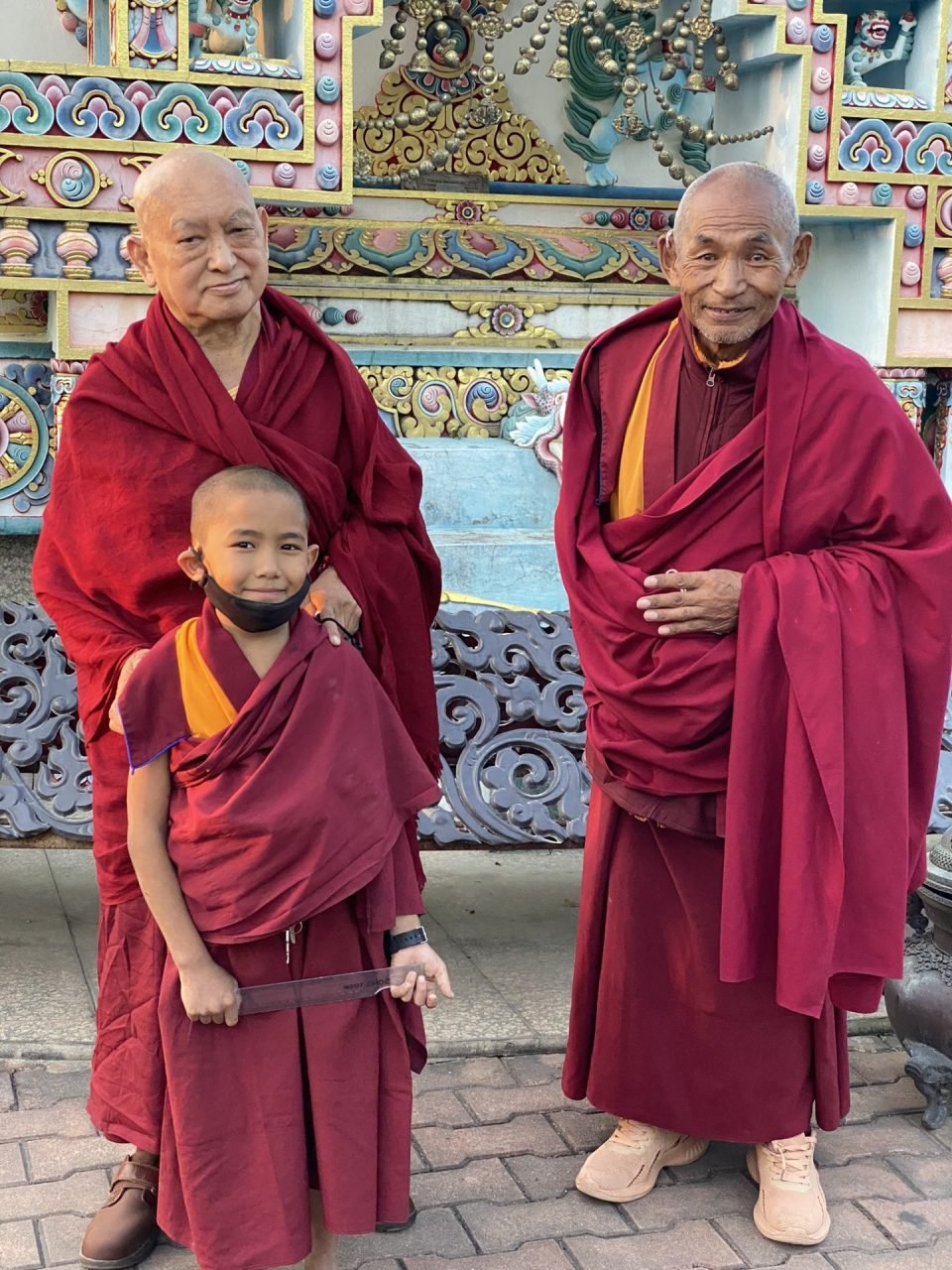
Gen Ngawang Namgyal, pictured right, with Lama Zopa Rinpoche and the young Rigsel Rinpoche, November 2021, Kopan Monastery, Nepal. Photo by Ven. Roger Kunsang.
Gen Ngawang Namgyal died in Kathmandu, Nepal, on July 5, 2022.
Gen Ngawang Namgyal was one of the first monks at Lawudo and Kopan Monastery. Before his passing on July 5, Lama Zopa Rinpoche visited him at Karuna Hospital, offering prayers and pujas for him, at his bedside. We invite you to rejoice in his life, living in morality and serving the Dharma. Please offer prayers at this critical time for him, that he may quickly attain enlightenment or be born in a pure land where he can become enlightened quickly.
Gen Ngawang Namgyal was born in Solo Khumbu, Nepal. His father had a close connection with Lama Zopa Rinpoche when both he and Rinpoche were young. He ordained as a child and split his early life between the villages of Thame and Lawudo, sometimes receiving teachings from Lama Zopa Rinpoche when Rinpoche would visit Lawudo in the very early days. He later arrived at Kopan Monastery from Lawudo during Kopan’s very first days, receiving teachings from Lama Yeshe, Lama Zopa Rinpoche, Khensur Lama Lhundrup, and others, as the monastery began to take form.
Gen Ngawang Namgyal shared the following from a June 2020 interview about his time during the founding of Kopan:
“At Kopan Monastery also texts were rare. At night we would copy out Tenets and prayers and other texts on our own notebooks, then Lama Yeshe would teach us how to recite prayers and so forth. We carried on like that. From that time, I’ve stayed at Kopan, for a long time. The number of monks has gradually increased, the studies and facilities and so forth gradually becoming better and better without much trouble. We all work together very well. It’s not that those of us here from the beginning have done everything. Everybody has worked very hard to make it what it is.”
While the monastery was developing, Gen Ngawang Namgyal would continue to travel back to Lawudo. Life was challenging there, and the small group of Lawudo monks had to beg for potatoes at times for food. Eventually, as the number of monks increased at Kopan, and trips to Lawudo became more difficult, he moved to Kopan permanently, where he would spend the rest of his life.
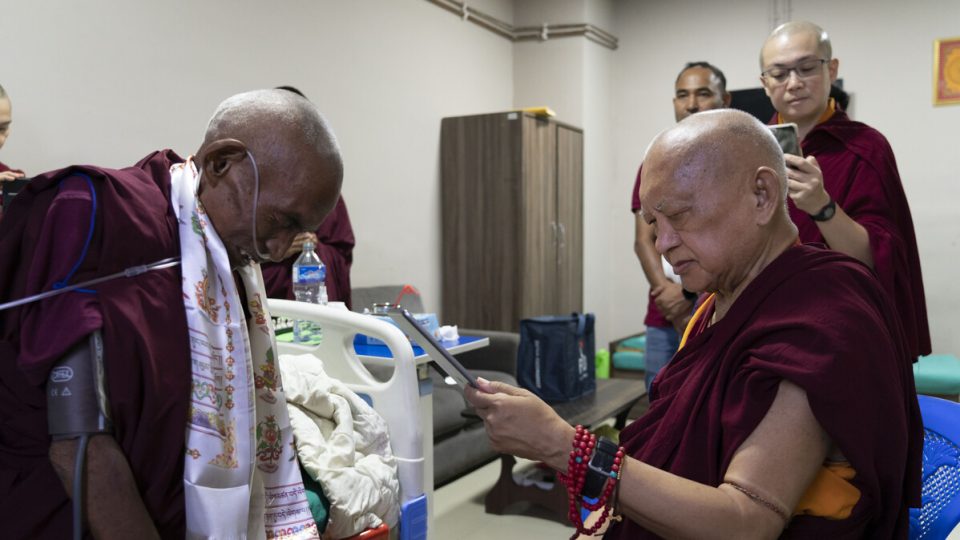
Lama Zopa Rinpoche reciting mantras for Gen Ngawang Namgyal just before he passed away at Karuna Hospital. Gen Namgyal was one of the first monks of Kopan and Lawudo Monasteries. Kathmandu, Nepal, June 2022. Photo by Ven. Lobsang Sherab.
To conclude the 2020 interview about his life at Kopan, Gen Ngawang Namgyal shared:
“In dependence on [the lamas’ and so many supporters’] kindness our monastery has developed and improved. The main improvement is subduing one’s own mind, improving oneself depends on subduing the mind. It’s just as it says in the prayer:
‘Bless me that my mind becomes Dharma, that Dharma becomes the path, and that path be without obstacles.’
“And then if one can make effort until reaching the state of buddhahood that is excellent. Just external development is not development. In order to develop internally we need study, but to study and not understand how to use that to develop internally one becomes very strange. To use the studies one has put within to develop and improve as a person we need to work at using methods to subdue our minds through practice. When we have external needs fulfilled with favorable conditions, these are just external things. The main thing is to improve our minds by improving our studies and improving our practice in order to gradually achieve liberation and enlightenment. You all probably know all this. So, this is what little I have to say.
“May Lama Thubten Zopa Rinpoche have a long stable life, and all his holy activities spread, and whatever Lama Thubten Zopa Rinpoche intends, may this be effortlessly and spontaneously accomplished. Then also, may all the various foreigners who have helped our monastery develop through sponsorship and their efforts caring for the monastery, they have really wonderfully served the monastery, then all the ordained Sangha, and the teachers, for all the benefactors, and for all I offer prayers. We should not pray just for ourselves alone that we achieve the state of enlightenment, that’s not good, but if we can pray for all sentient beings to achieve the state of enlightenment that’s best.”
Lama Zopa Rinpoche requests that students who read obituaries pray that the person mentioned finds a perfect human body, meets a Mahayana guru, and becomes enlightened quickly, or be born in a pure land where the tantric teachings exist and they can become enlightened.” While reading obituaries we can also reflect on our own death and impermanence prompting us to live our lives in the most meaningful way. More advice from Lama Zopa Ripoche on death and dying is available, see Death and Dying: Practices and Resources (fpmt.org/death/).
To read more obituaries from the international FPMT mandala, and to find information on submission guidelines, please visit our new Obituaries page (fpmt.org/media/obituaries/).
- Tagged: ngawang namgyal, obituaries, obituary
24
Khyongla Rato Rinpoche Passes Away
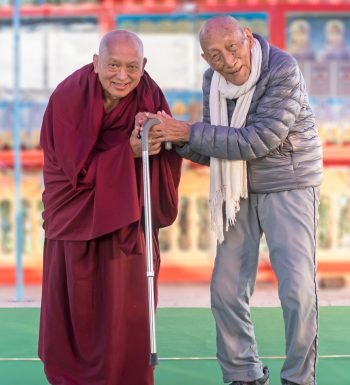
Lama Zopa Rinpoche with Khyongla Rato Rinpoche, Root Institute, Bodhgaya, India, 2018. Photo by Ven. Lobsang Sherab.
We are saddened to share the news that Khyongla Rato Rinpoche peacefully passed away in Dharamsala, India, on May 24, 2022.
Khyongla Rato Rinpoche was a reincarnate lama and scholar of the Gelugpa order of Tibetan Buddhism, who was born in 1923 in the Dagyab region of Kham, in southeastern Tibet. In 1928, senior Gelugpa monks divined that a five-year-old boy living in this remote part of Tibet was the reincarnation of the ninth Khyongla. On his sixth birthday, monks on horseback took him from his parents’ home to a monastery some distance away where he was installed as its spiritual head.
For over three decades, he lived the life of a monk, studying at the most famous monasteries in Tibet and earning the Lharampa Geshe degree. In 1959, along with thousands of monks as well as His Holiness the Dalai Lama, he fled the Chinese army on foot over the Himalayas to safety and to a radically different life in India, Europe, and eventually the United States.
In 1975, Khyongla Rato Rinpoche founded The Tibet Center, in New York City, US.
On May 24, 2022, The Tibet Center shared the following announcement:
“Venerable Khenpo Rinpoche Nicholas Vreeland is with him and is currently performing prayers along with Rato monks in Rinpoche’s presence. His Holiness’ office has been informed and [His Eminence] Venerable Ling Rinpoche is advising Venerable Vreeland. Venerable Vreeland asks us to kindly say prayers on Rinpoche’s behalf and we will have a further statement in the near future.”
Khyongla Rato Rinpoche was a teacher of FPMT Spiritual Director Lama Zopa Rinpoche, who received many oral transmissions from him over the years. In recent years, Khyongla Rato Rinpoche also visited FPMT’s Root Institute and Tushita Meditation Centre, both in India.
On May 24, 2022, Lama Zopa Rinpoche and Kopan Monastery offered Lama Chopa puja for the fulfillment of all the wishes of Khyongla Rato Rinpoche.
The passing of this highly respected teacher is a great loss for his students and the world. Please pray for the continuation of his good works far, far into the future.
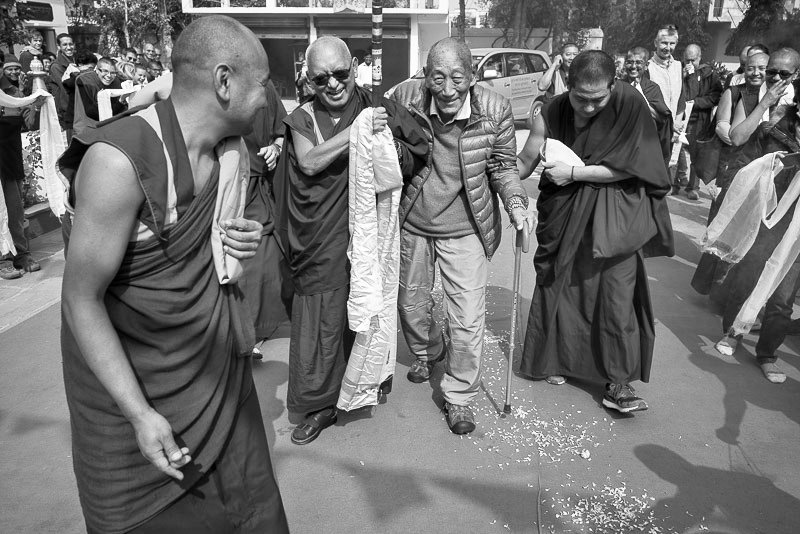
Lama Zopa Rinpoche with Khyongla Rato Rinpoche, Root Institute, Bodhgaya, India, 2018. Photo by Khen Rinpoche Nicholas Vreeland.
UPDATE: Khen Rinpoche Nicholas Vreeland shared photos of Khyongla Rato Rinpoche’s passing in the post “Rinpoche Has Departed” on his website.
FPMT.org brings you news of Lama Zopa Rinpoche and of activities, teachings, and events from over 150 FPMT centers, projects, and services around the globe. If you like what you read, consider becoming a Friend of FPMT, which supports our work.
- Tagged: khyongla rato rinpoche, obituaries, obituary
25

Dr. Giorgio Armato.
Dr. Giorgio Armato, 74, died at home in Genoa, Italy, on January 21, of cancer.
Dr. Giorgio Armato graduated from the Faculty of Medicine and Surgery in Genoa, Italy, and specialized in oncology. He met Lama Zopa Rinpoche in 1975 and spent many years at Kopan Monastery in Nepal. Among his many achievements, he first built an emergency room in Kopan itself and another at the foot of the hill. He then built a small three-story hospital there, thanks to his own work and donations from friends.
In his practice in Genoa, Giorgio helped and cared for the poor and needy, and he went on missions to offer surgical operations in Zaire, Burundi, Madagascar, Guatemala, and Nepal.
Friend Ven. Siliana Bosa shared, “Giorgio was very devoted to Lama Zopa Rinpoche, and he loved Kopan. He had a strong connection also with the Catholic church and often, during his summer holiday, went to Africa with a Franciscan organization to do surgical operations in areas of great conflict.”
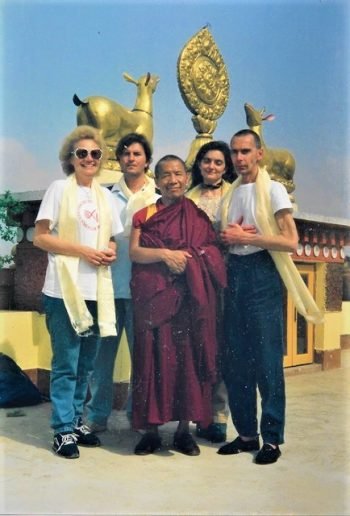
Dr. Giorgio Armato at Kopan Monastery, Nepal, with Khensur Rinpoche Lama Lhundrup, his sister Graziella, a doctor, and a nurse, 1999.
“He put others before himself and helped many people with acupuncture and gave all the offerings he received to people in need. Giorgio had a good sense of humor. Because of his broken English, he would say [the Italian word] ‘allora’ every few words, and so in Kopan they called him Doctor Allora. His main practices were Medicine Buddha and Vajrayogini, which helped him to face the last months of his sickness with serenity. He actually told me that he was not afraid to die, so he had a peaceful departure,” Ven. Siliana said.
Ven. Lucia Bani shared, “Giorgio has been a dear Dharma friend for many years and for many years he was my sponsor. Giorgio was a man of few words but many actions. He was honest and sincere, and totally dedicated to help others. He was an example of great strength especially for how he faced his illness and death. He never complained, remained serene, and had a mind always ready to ask, ‘How are you?’ Giorgio had a meaningful life and left with great dignity and courage. What a wonderful gift!”
With thanks to Dr. Giorgio’s sister, Graziella Armato, for providing details for this obituary.
Lama Zopa Rinpoche requests that students who read obituaries pray that the person mentioned finds a perfect human body, meets a Mahayana guru, and becomes enlightened quickly, or be born in a pure land where the tantric teachings exist and they can become enlightened.” While reading obituaries we can also reflect on our own death and impermanence prompting us to live our lives in the most meaningful way. More advice from Lama Zopa Ripoche on death and dying is available, see Death and Dying: Practices and Resources (fpmt.org/death/).
To read more obituaries from the international FPMT mandala, and to find information on submission guidelines, please visit our new Obituaries page (fpmt.org/media/obituaries/).
- Tagged: giorgio armato, obituaries
10
Rowena Mayer, 81, died in Santa Fe, New Mexico, United States, on January 26, 2022, of cancer
By Don Handrick
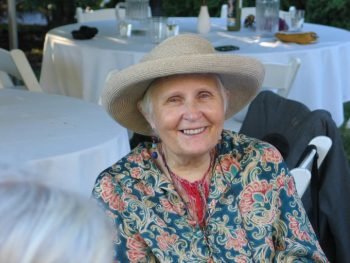
Rowena Mayer, 2010. Photo courtesy of Rowena’s Facebook page.
Rowena Mayer met the Dharma for the first time in the early 1980s when she attended a teaching with His Holiness the Dalai Lama in Santa Cruz, California. After that she started going to Vajrapani Institute in Boulder Creek for classes and retreats while raising her family in Big Sur. One of her California Dharma friends David Molk recalled Rowena’s cheerful perseverance in her practice as she worked as a school teacher. She lived right at Pacific Valley School in Big Sur in chaotic, cramped circumstances, which might have discouraged or distracted a less stable and persistent practitioner.
Rowena moved to Santa Fe, New Mexico, in 2002, and shortly afterward connected with Thubten Norbu Ling Tibetan Buddhist Center(TNL), where she served as the center director from 2006 until early 2018, guiding the development of its programs and events, and helping the community to grow into one of the largest Buddhist centers in Santa Fe. As the “mommy” of the center, Rowena was a constant presence, greeting and welcoming nearly everyone who came through its doors.
During her years as center director, she persisted in inviting Geshe Thubten Sherab to return to New Mexico, where he had worked at FPMT’s International Office when it was located in Taos from 2001-2003. It was her strong wish that Geshe Sherab become the center’s first resident geshe, and in 2013 he agreed to do that on a part-time basis, sharing the teaching duties for half of each year with TNL’s other resident teacher, myself.
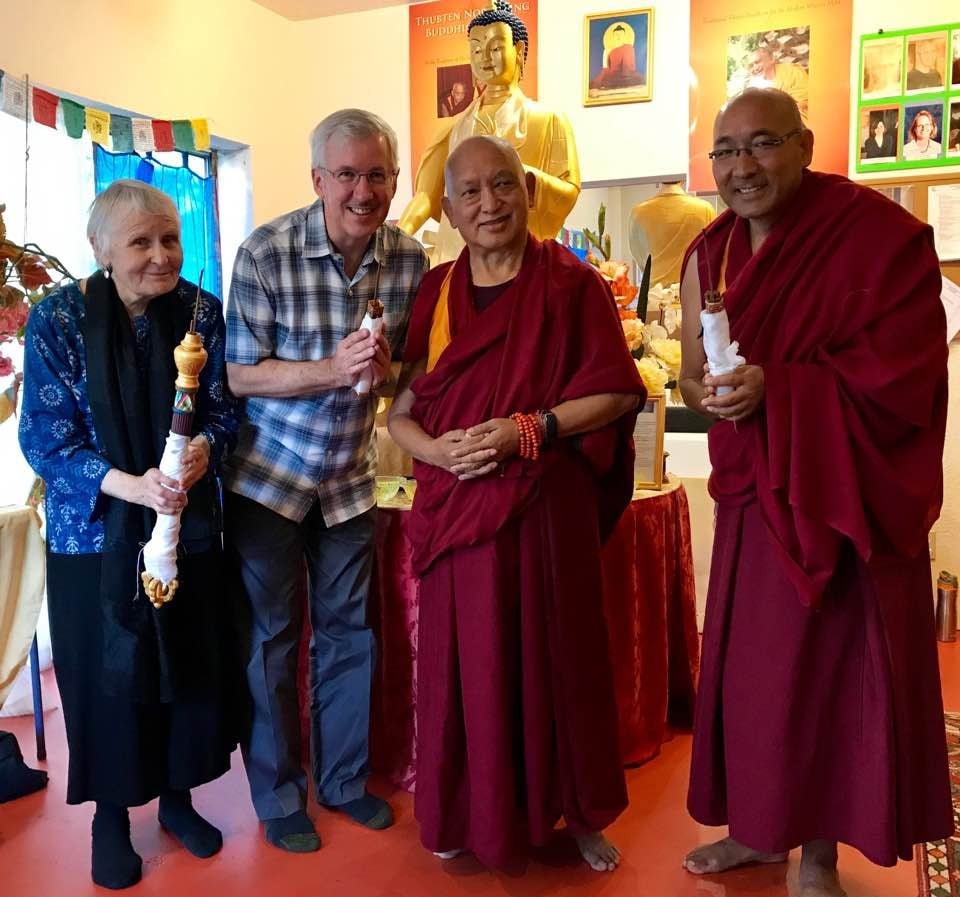
Rowena with Lama Zopa Rinpoche, Geshe Thubten Sherab, and Don Handrick at Thubten Norbu Ling, Santa Fe, 2017. Photo by Ven. Sarah Thresher.
She also continually invited Lama Zopa Rinpoche to come to Santa Fe. And her years of dedication to TNL, the FPMT organization, and Rinpoche resulted in his weeklong visit in August 2017, which included several teachings and initiations that were attended by over 200 people. The blessings of Rinpoche’s visit continue to benefit TNL in that it has grown into a large community of practitioners with an expanded program and a new building that is set to open later in 2022.
Nearly a hundred members of the TNL and FPMT community who knew Rowena joined an online Medicine Buddha puja that was conducted for her by Geshe Sherab on the evening of January 26, 2022. Rowena’s daughters and other family members watched the puja that night with her, and she took her last breath shortly before the puja ended. A few days before she passed, she had mentioned to one of her daughters that Medicine Buddha had visited and spoke with her, so it seemed most auspicious that her final moments came during that particular puja.
Rowena will be remembered for her incredible kindness and the loving concern she showed to so many. Moreover, as a practitioner, she demonstrated a genuine enthusiasm for the Dharma that will continue to inspire all those who practiced with her. What a blessing it was to have had her in our lives!
*After reading this obituary, Lama Zopa Rinpoche commented: “From the person’s side, to live the life as a very good human being and from Medicine Buddha’s side, the most powerful is to make prayers to and practice in degenerate times (from sutra and from tantra). Hence Rowena had no worries at the time of death. Whoever one practices in the life can therefore appear to oneself at death time.”
Lama Zopa Rinpoche requests that students who read obituaries pray that the person mentioned finds a perfect human body, meets a Mahayana guru, and becomes enlightened quickly, or be born in a pure land where the tantric teachings exist and they can become enlightened.” While reading obituaries we can also reflect on our own death and impermanence prompting us to live our lives in the most meaningful way. More advice from Lama Zopa Ripoche on death and dying is available, see Death and Dying: Practices and Resources (fpmt.org/death/).
To read more obituaries from the international FPMT mandala, and to find information on submission guidelines, please visit our new Obituaries page (fpmt.org/media/obituaries/).
- Tagged: obituaries, rowena mayer
1
Eléa Redel, 74, died of rheumatoid polyarthritis, on January 7, 2022, in Lavaur, France
By Christian Charrier

Eléa Redel, 2021. Photo courtesy of Institut Vajra Yogini.
Eléa Redel was finally released from her long-term physical suffering on January 7, 2022, at Institut Vajra Yogini, France. Geshe Loden, our resident teacher, was at her side and informed Lama Zopa Rinpoche, who responded immediately. Instructions were given and Eléa, lying on her bed, entered straightaway into meditation while Geshe-la and IVY director Nicolas Brun offered practices. She remained absorbed for five days without showing any external sign of death. A message came from His Holiness the Dalai Lama’s secretary expressing that Chenrezig was taking care of the departure of our dearest friend.
Eléa was born in France in 1947. She met Lama Yeshe in 1979 in Dharamsala and became actively involved in the FPMT organization. In France, she served as a translator and founder of Vajra Yogini Publications (now “Editions Mahayana”). In India, she was the director of Lotsawa Rinchen Zangpo Translator Program, one of the leading schools in the training of specialized interpreters and translators from Tibetan.
Eléa was a charismatic and sensitive person, and people enjoyed her company. She was also an intelligent student, who got her inspiration and wisdom from her kind heart. Although she never studied in a strictly academic way, her knowledge of Dharma was both very thorough and practical. She had an unwavering devotion to His Holiness the Dalai Lama, Lama Yeshe, and Lama Zopa Rinpoche, whose words she translated or helped to translate into French. She was a reliable and meticulous translator and copy editor.
Eléa was the first person I met when I arrived at Institut Vajra Yogini in 1981 during Lama Zopa Rinpoche’s visit. She immediately struck me as being a leading figure there. At this time, she would wear rainbow-colored woolen gloves with cut-off fingers as she spent her days typing on an old machine. (We did not have computers or even heaters in those days.) I soon discovered that behind her rainbow gloves were fingers that had started to swell and take on a deformed aspect. Day by day, as her whole body slowly transformed, pain and infirmity became more and more vicious. But she was brave and did not let her crippling disease stop her from serving the community and the Dharma. She also continued to travel to India and Nepal for teachings and retreats, and went on a pilgrimage to Tibet with Rinpoche.
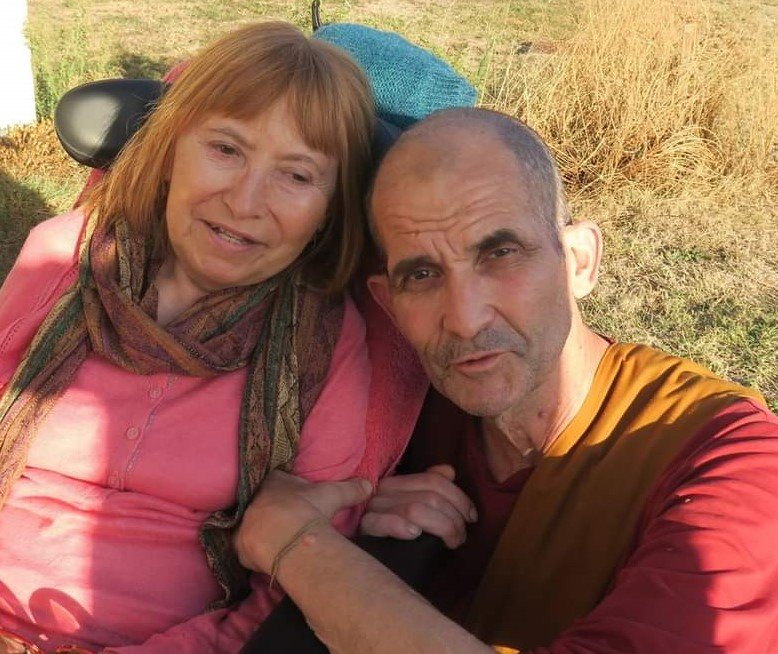
Eléa with Ven. Charles Trebaol. Photo courtesy of Institut Vajra Yogini.
Although tortured physically, her inner rainbow light continued to shine through and illuminate her environment and friends. Her suffering gradually became a catalyst for spiritual growth. And her way of accepting her illness, with forbearance and patience, revealed a true bodhisattva heart. Her courage was indeed a source of admiration and inspiration for many of us.
In the last years of her life she could not eat, drink, stand up, walk, go to bed, or get up by herself. She needed assistance every time she moved and had to cope mentally with her dependence on others for whatever activity she had to perform or anything she wished to do. Very tough to take for such an independent person!
Gradually she had to let go of her work as a translator and copy editor. In the last years, she concentrated mainly on doing her practices and advised whoever came to visit her. During one of my last visits, she told me that if she had the chance to find another precious human life, she would like to come back as a graceful and sensuous lady whose practice of Dharma would benefit others by “mere sight.” Isn’t it strange that we all wish to be what we already are! Eléa was indeed a beautiful lady, wearing the armor of patience and perseverance, and exemplifying a bodhisattva training in the six perfections. Remembering her, my yo-yo heart fluctuates between sadness and joy.
You can read “Changing Suffering into Happiness” written by Eléa Redel in 1999 for Mandala magazine. This piece has also now been translated into French.
Lama Zopa Rinpoche requests that students who read obituaries pray that the person mentioned finds a perfect human body, meets a Mahayana guru, and becomes enlightened quickly, or be born in a pure land where the teachings exist and they can become enlightened.” While reading obituaries we can also reflect on our own death and impermanence prompting us to live our lives in the most meaningful way. More advice from Lama Zopa Ripoche on death and dying is available on Lama Zopa Rinpoche’s advice page.
- Tagged: obituaries
27
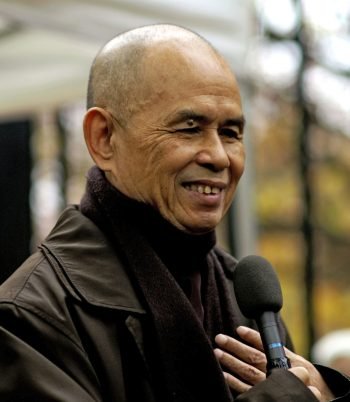
Thich Nhat Hanh, Paris, 2006. Photo by Duc (pixiduc) from Paris, France, CC BY-SA 2.0 via Wikimedia Commons.
Buddhist monk, Vietnamese Zen Master, engaged-buddhism proponent, and peace activist Thich Nhat Hanh passed away on January 22, 2022, at the age of 95. Spiritual leaders as well as FPMT students and centers around the world have been sharing the deep appreciation they had for this teacher of non-violence and mindfulness.
His Holiness the Dalai Lama released the following message of condolence:
“In his peaceful opposition to the Vietnam war, his support for Martin Luther King and most of all his dedication to sharing with others not only how mindfulness and compassion contribute to inner peace, but also how individuals cultivating peace of mind contributes to genuine world peace, the Venerable lived a truly meaningful life. I have no doubt the best way we can pay tribute to him is to continue his work to promote peace in the world.”
His Eminence the 7th Kyabje Ling Rinpoche encouraged everyone to rejoice and to be inspired by Thich Nhat Hanh’s exemplary life of tireless service to the Buddhadharma and to promoting non-violence, peace and harmony in Vietnam and throughout the entire world.
We invite you to read two teachings from Thich Nhat Hanh previously published in Mandala magazine, Embracing Anger, and Going Home to Yourself.
For more on Thich Nhat Hanh and his passing, please visit the Plum Village website.
FPMT.org brings you news of Lama Zopa Rinpoche and of activities, teachings, and events from FPMT centers, projects, and services around the globe as well as from students, teachers, and others in the FPMT community. If you like what you read, consider becoming a Friend of FPMT, which supports our work.
- Tagged: obituaries, thich nhat hanh
- Home
- News/Media
- Study & Practice
- About FPMT Education Services
- Latest News
- Programs
- New to Buddhism?
- Buddhist Mind Science: Activating Your Potential
- Heart Advice for Death and Dying
- Discovering Buddhism
- Living in the Path
- Exploring Buddhism
- FPMT Basic Program
- FPMT Masters Program
- FPMT In-Depth Meditation Training
- Maitripa College
- Lotsawa Rinchen Zangpo Translator Program
- Universal Education for Compassion & Wisdom
- Online Learning Center
- Prayers & Practice Materials
- Overview of Prayers & Practices
- Full Catalogue of Prayers & Practice Materials
- Explore Popular Topics
- Benefiting Animals
- Chenrezig Resources
- Death & Dying Resources
- Lama Chopa (Guru Puja)
- Lama Zopa Rinpoche: Compendium of Precious Instructions
- Lama Zopa Rinpoche: Life Practice Advice
- Lama Zopa Rinpoche Practice Series
- Lamrim Resources
- Mantras
- Prayer Book Updates
- Purification Practices
- Sutras
- Thought Transformation (Lojong)
- Audio Materials
- Dharma Dates – Tibetan Calendar
- Translation Services
- Publishing Services
- Teachings and Advice
- Find Teachings and Advice
- Lama Zopa Rinpoche Advice Page
- Lama Zopa Rinpoche: Compendium of Precious Instructions
- Lama Zopa Rinpoche Video Teachings
- ༧སྐྱབས་རྗེ་བཟོད་པ་རིན་པོ་ཆེ་མཆོག་ནས་སྩལ་བའི་བཀའ་སློབ་བརྙན་འཕྲིན།
- Podcasts
- Lama Yeshe Wisdom Archive
- Buddhism FAQ
- Dharma for Young People
- Resources on Holy Objects
- Ways to Offer Support
- Centers
- Affiliates Area
- Teachers
- Projects
- Charitable Projects
- Make a Donation
- Applying for Grants
- News about Projects
- Other Projects within FPMT
- Support International Office
- Projects Photo Galleries
- Give Where Most Needed
- FPMT
- Shop
Translate*
*powered by Google TranslateTranslation of pages on fpmt.org is performed by Google Translate, a third party service which FPMT has no control over. The service provides automated computer translations that are only an approximation of the websites' original content. The translations should not be considered exact and only used as a rough guide.In the lam-rim, there’s some advice on how to get up early in the morning without being overwhelmed by sleep. Before getting into bed the night before, wash your feet while thinking of light. Try it; it works.







